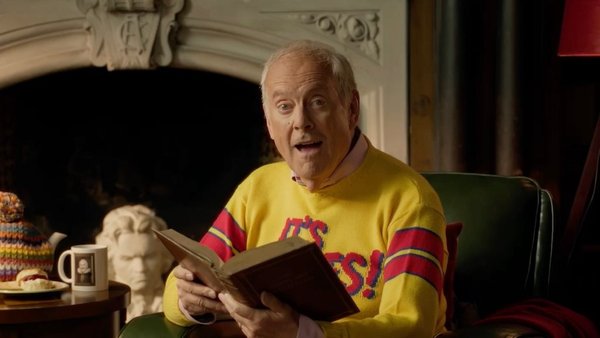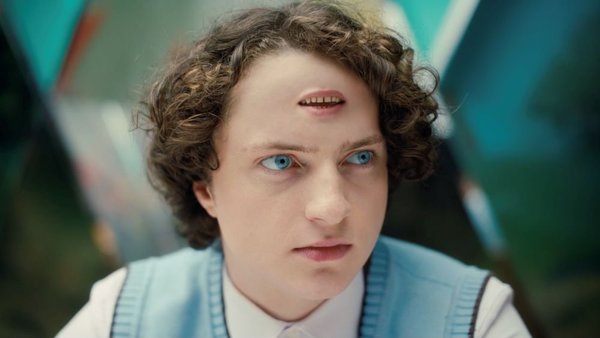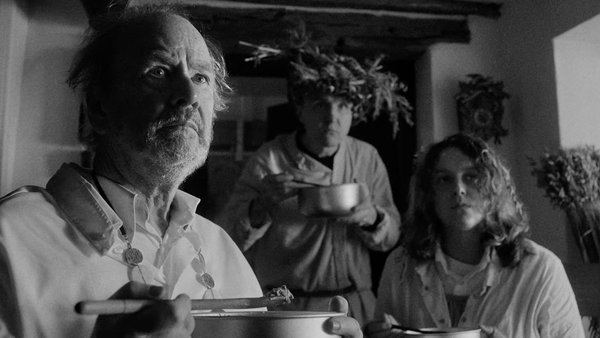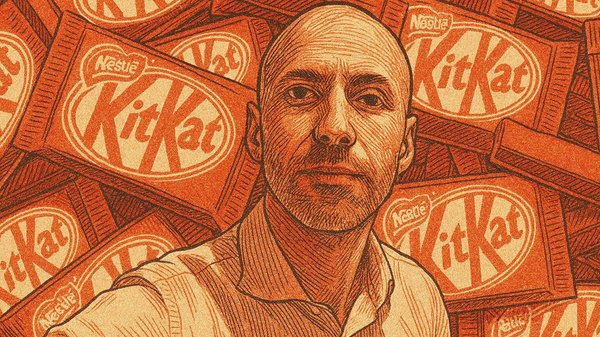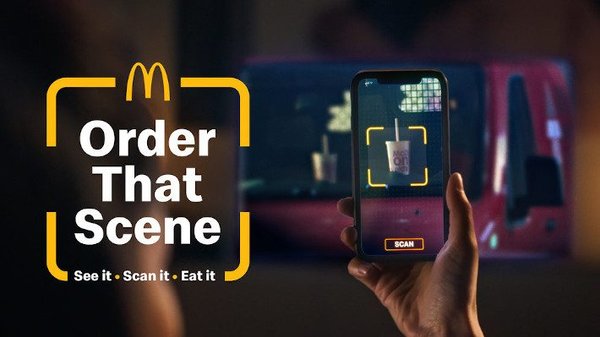
At a glance /
- In the late 2000s Specsavers was in an covetable position. Not only was it the market leader for UK optometry, but its TV ads, famed for their sight gags, had helped transition the brand’s tagline into the common vernacular of the British public
- ‘Should’ve gone to Specsavers’ became a tool that the brand could routinely use to playback culture. However, when the rise of social media fragmented people’s media use at the start of the 2010s, Specsavers found itself unable to achieve the same broad reach with its TV campaigns
- As well as needing to find new ways to reach its audience, Specsavers had to tackle the misperception that it was more of a supermarket chain for glasses than an expert in healthcare
- Specsavers responded by evolving its tagline to operate in new media channels and finding ways to use its characteristic humour to tell stories about its business that emphasised its healthcare expertise. It helped the brand become the eighth most popular retail brand in the UK, generating £2bn UK revenue in 2023
In March, a white van was found mysteriously abandoned in the middle of Edinburgh having been thrusted off its rear wheels by a set of automatic bollards. It appeared the driver had missed the sign that read ‘Caution. Automatic bollards in operation. No parking’. Upon closer inspection though, the van was emblazoned with the Specsavers logo. While some believed it to be a genuine mistake of hilarious coincidence, others recognised it for the clever marketing stunt that it was. Regardless, everyone implicitly recognised that the driver ‘Should’ve gone to Specsavers’.

In the UK in the late 2000s if you made a sight-based gaffe in public there was a good chance, you would be met with the advertising slogan ‘Should’ve gone to Specsavers’. The optometry brand had so effectively used humour to reflect on human error in its TV ads that the tagline had become part of everyday conversation. Two decades later, ‘Should’ve’ remains the brand’s most distinctive asset, a punchline so recognisable that with the merest hint from Specsavers, people will deliver the joke for themselves.
Since the Should’ve brand platform was first used, it has resonated with people across all demographics and contributed significantly to the brand’s growth. The 2009 Specsavers ad Rollercoaster, for example, was one of the most memorable UK TV ads of the 2000s, according to YouGov, which reported that 82% of respondents had seen the spot.
By 2014, advertising had cumulatively contributed to £1.1bn of incremental profit for the brand. Today, Specsavers remains the market leader for optometry, owning more than 1,000 stores in the UK and Ireland, offering eye care to over 13 million people across these regions each year, and generating £2bn in UK revenue in 2023.
However, Specsavers’ became somewhat a victim of its own success. With the fame and expansion of the business, came the misperception that it was more of a supermarket chain for glasses than an expert in healthcare. Many of the consumers who wouldn’t consider Specsavers enjoyed the Should’ve ads, but they weren’t enough to make them switch opticians.
This issue was coupled by the fragmentation of people’s media use that came with the rise of social media. People were still watching TV, but more of their attention had switched to new platforms. The TV ads for which Specsavers was best known no longer offered the same reach. It made it harder to achieve the same cultural relevance with the same number of people through traditional campaign cycles.
Specsavers needed to refocus its approach. This didn’t mean ditching Should’ve and its characteristic humour for a more serious tone. But the brand did need to find interesting ways to maintain fame across new media channels and play with its tagline to lean into its healthcare credentials.
Richard James, Specsavers
Creating a clear image
Despite dominating advertising spend versus competitors since it first opened its stores in 1984, it wasn’t until the early 2000s that Specsavers first landed on the humour it is recognised for today. Before then its ads had focused on the rational aspects of optometry services. As Matthew Philip, head of strategy at MG OMD (Specsavers’ long-term media partner), says, ‘They were an advert for eyesight, an advert for opticians, not necessarily for Specsavers as the brand.’
While these ads had contributed to the brand becoming the market leader within its first 10 years of operating, in 2003 Specsavers concluded that its campaigns were lacking a consistent identity, which limited the returns it could make from its dominant spend. Graham Daldry, then creative director at Specsavers, proposed that humour could help the brand build salience. It was a significant shift given that previously, creatives had been hamstrung by the brand’s internal guidelines which dictated ‘no alcohol, no smoking, no nudity, no sex and no humour’.
The change of tack resulted in the first iteration of Should’ve gone to Specsavers. At this time the jokes focused on bad glasses, or situations where people might lose their only good pair. It enabled the brand to draw attention to the quality and style of its glasses, as well as its two for one offering. By the end of 2005 almost 30% of glasses wearers could spontaneously recall a specific Specsavers ad, compared to fewer than 10% at the beginning of 2002. Notably, sales increased significantly beyond store growth for the period.
For all of the success that Should’ve brought, by the end of 2005 Specsavers was lagging behind competitors on metrics such as professionalism, quality and style. Specsavers decided to dump the humour for more abstract, high production TV spots that focused more on fashion and quality. The switch didn’t pay off. Despite increased media spend, noticeability and memorability metrics dropped. The number of people who could recall a specific Specsavers ad had halved. In 2008, Specsavers returned to Should’ve, and for the first time landed on the joke it is renowned for today – relatable, if not slightly hyperbolised, sight-based errors of judgement.
Jokes around poor eyesight could have alienated the brand’s core audience, making them the butt of a joke. ‘We’re incredibly sensitive to this,’ says Richard James, creative director at Specsavers. ‘When we’re writing the scripts we take a huge amount of care to make sure that people are on the side of the hero. We’re not a brand talking down, it’s more like a mate in a pub telling you a joke.’
The new tone made the platform more malleable. Anywhere there was room for a mishap, there was room for Should’ve. It enabled Specsavers to play back popular culture and elevate its relevance. ‘The advertising idea itself was made to fit in with the cultural landscape at the time,’ explains Philip. ‘The cultural landscape was a little bit of 80s nostalgia, over-the-top celebrities and it was also the dying days of sketch comedy, which was very much based around a catchphrase.’ Specsavers leaned into this, creating TV ads that featured the likes of TV chef Gordon Ramsay at the height of his fame and brought back iconic British TV characters, such as Virgil from Thunderbirds and Basil Fawlty.
Shifting the focus
While TV ads were by no means the only string to Specsavers’ bow, they were the most recognisable and best-loved Specsavers comms until the early 2010s. But then the media landscape shifted. The number of TV channels increased, so audiences had different cultural reference points based on their viewing habits. Plus, with the rise of social media, fewer people were watching TV in general. Phillip explains, ‘We’re probably reaching half the same number of people for the same cost ad campaign that we were doing 10 years ago. It used to be that if you had a big enough campaign, you could pretty much reach 90% of glasses wearers. Now, however much you spend, you’re just not going to reach that last 25%.’
Specsavers had to ramp up its presence on social media. Fortunately, Should’ve allowed it to seamlessly step in at relevant moments in trending culture. A simple retweet or a pair of glancing eyes in response to someone’s post about a perceptual error said it all. In many ways, it was what Specsavers had always done with TV, but on social Specsavers didn’t need to wait for the next campaign cycle to respond.
The brand assembled a permanent in-house team dedicated to finding moments in popular culture ripe for sight-based gags. The permanence of this team, combined with shrewd media buying and planning, meant that head-in-hands moments like the South Korean flag being displayed before a North Korean football match at the London Olympics in 2012, or the mis-announcement of La La Land as Best Picture at the 2017 Oscars, could within 24 hours become not just social media posts but whole page spreads in national newspapers, billboards at airports and even TV ads.

This has evolved into what Specsavers calls its always-on strategy, and it has enabled Specsavers to draw significant engagement on social media in particular. Between March 2023 and February 2024, alongside its social agency Tangerine, Specsavers’ social media team generated 287 million impressions and over 6.6 million interactions. Since the formation of Specsavers social team and the start of its work with Tangerine in 2019, average positive brand sentiment online has risen to 44%, from 0.34% prior to 2019.
Ian Maybank, head of planning at Specsavers, explains that this always-on approach is about ‘maximising exposure for the brand, for what we call “weeks on end”, making sure that we’ve got as many continuous weeks where we’re as visible to the public as possible, and really placing the consumer at the heart of our marketing plan’.
Finding the right times to show up with a distinctive asset is key when it has been used for over 20 years. The tagline itself is old, but Specsavers doesn’t want the joke to get old. ‘You never want to see Should’ve gone to Specsavers as a straitjacket,’ says Philip. ‘It should be this thing that powers the brand but enables us to do other things around it as well. And obviously to make Should’ve gone to Specsavers better and relevant for a different world’.
Richard James, Specsavers
Now you see me
During the pandemic, Specsavers had been left little choice but to put Should’ve to the side as it was an inappropriate time to tell people to go to stores. While Specsavers had their fun with the line when the prime minister’s chief adviser claimed he drove 30 miles to Barnard Castle to test his eyesight, people really were not supposed to visit the opticians unless it was essential. But after lockdowns ended, there were suddenly millions of customers who were overdue for an eye test.

The brand responded with its biggest fully integrated campaign to date, coined Should’ve 2.0. The campaign featured a typical 30-second Should’ve spot, which depicted a delivery driver scaling tens of flights of stairs only to realise he was at the top of the wrong tower block. But Should’ve 2.0 also saw the brand experimenting with new executions. In a first for UK broadcasting, Specsavers persuaded ITV and Channel 4 to make glaring mistakes during their continuity announcements, each wrongly promoting the shows of each other broadcaster’s channels. The use of TV was complemented with several purposefully inverted print ads and incorrectly installed billboards, both in real OOH and as easter eggs in mobile and console games. On social media Specsavers contacted people who had tweeted real-life Should’ve moments, and with their permission repurposed the posts for their social ads.
Having seen its brand awareness drop to an all-time low following two years of lockdowns, Specsavers’ awareness score rose from 21 to 25.3 after the campaign’s launch. The brand’s consideration score grew from 18.2 to 20.4, while positive brand sentiment increased by 33%. Should’ve 2.0 received 20,553 mentions on social, was covered in more than 191 news articles and delivered an earned reach of over 17 million. Most importantly, during the campaign’s first week sight tests rose by 13%.
Rather than launch a new platform, Specsavers had found new ways to reconstruct existing memory structures around its brand. ‘You can supercharge those memories by doing something a little bit different,’ says Philip. ‘The problem most clients have is they interpret that as going let’s try something entirely new. Specsavers’ approach is absolutely what it should be, which is don’t change the strategy. The strategy is incredibly effective.’

A problem of perception
While Covid had significantly impacted the number of people attending optician’s services, it also left people with an elevated awareness of their health. This has provided an opportunity for Specsavers to tackle the misperception about its brand. Lisa Hale, head of consumer PR, brand activation and social media at Specsavers, explains, ‘We have a challenge of coming across as a glasses supermarket chain, when in fact our stores are locally owned and run by experts.’
The increased health awareness meant people were more likely to be receptive to stories that emphasised Specsavers’ expertise. As James explains, ‘Research showed that actually, some of the stories that were at the heart of the business made a real difference to people. It’s about being able to tell people about the kind of care that we give, and how we deliver that in a professional way.’ He adds, ‘We wanted to be able to use Should’ve to tell some stories that might persuade people to consider us.’
Specsavers had learned from past mistakes that ditching humour in search of professionalism was not the way to do this. ‘Being in a low interest category is one of the things that drives us using humour because even if we want to talk about professionalism, people just aren’t that interested,’ says James. ‘Should’ve is a door opener. By making us more likeable, when we do want to tell quite serious stories people are going to be more open to that, because we’ve done the groundwork with them.’
In 2022, Specsavers flipped the Should’ve tagline with a campaign that tackled a serious issue. It promoted Specsavers’ home visits to people with accessibility issues. Here, Should’ve simply wasn’t appropriate, but the brand found a way to play with the line and use a dose of self-deprecating humour to address the topic. In a 30-second spot, people reeled off the line ‘I don’t go to Specsavers’, seemingly scoffing at the idea, only to reveal that it’s because Specsavers comes to them.
I Don’t Go wasn’t just something that Specsavers stumbled upon. It was informed by several phases of qualitative research with the very people who didn’t consider the brand because of its healthcare misperception. These are people who Specsavers refer to as rejectors, those who are in the optical market, have had an eye test in the last two years or plan to within the next six months, and who actively say they wouldn’t consider Specsavers.
Throughout the development process for I Don’t Go, Specsavers spoke to rejectors who informed them that overtly claiming their healthcare credentials only worsened people’s perceptions, they also inferred that ditching Should’ve entirely wasn’t the right approach. It led the brand to telling the story about its domiciliary service, which poked fun at its own longstanding tagline. The campaign didn’t just appeal to those the service may cater towards, but surprisingly to Specsavers it also landed with a younger audience, among which the brand had started to notice an increase in rejectors.
Lisa Hale, Specsavers
Awareness of home visits rose from 28% to 56% after launch. More broadly 46% of rejectors said they felt better about the brand. Despite home visits predominantly serving an older audience, the 16-34 and 35-44 age brackets were the most likely to say they felt better about the brand. Overall, consideration increased 4 percentage points from pre-campaign to two months later. Rejectors also decreased from 34% to 29%. Although Specsavers wasn’t able to isolate cause and effect, the volume of sight tests among 20- to 39-year-olds increased 7.6% year-on-year in the three-month period following the campaign’s release. Across all audience groups Specsavers tested higher for perceptions of expertise, qualified staff, professionalism and quality.

‘I Don’t Go was massively good for the business in terms of shifting the dial,’ says James. ‘It delivered a professional message, it showed that you could use Should’ve in a domiciliary setting, which has always been one of the challenges, and it was incredibly impactful.’
Beyond its advertising, Specsavers has committed to improving accessibility to healthcare. The brand is working with homelessness charities to try to influence government policy that restricts people from accessing healthcare services if they don’t have a fixed address. Hale explains, ‘We have done a study to show that [improving healthcare access for people experiencing homelessness] is a particular interest for our rejectors and that’s something that would make them reconsider us. Democratising eye care is the reason that Specsavers was set up. [It’s about] creating safe spaces to make everyone feel that they’re welcome.’
Seen but not heard
The healthcare misperception not only impacts Specsavers on the optometry side of the business, but also its audiology services. A brand with a name so clearly tied to vision has a challenge in its quest to become synonymous with hearing care too. In the past year Specsavers has addressed this issue with the same characteristic humour that made its optometry services market leading. George Bryant, global chief creative officer at Golin, Specsavers’ PR agency, explains: ‘Humour removes barriers and walls. If you can use it, allied to purpose, you have a huge potential to welcome people in and get them to take action.’
In September 2023, Specsavers launched the second iteration of its Lost and Found campaign, which focused on the universal sounds that people love and would love to keep hearing, or rediscover. In addition to a 30-second spot that humorously showed people repeatedly playing these sounds for ASMR-like therapeutic effects, Specsavers also phonetically translated these sounds on billboards.
While the campaign only shifted top of mind brand awareness by 1 percentage point, prompted awareness rose by 3. The 2023 campaign performed significantly above Kantar Benchmarks for long-term impact on metrics such as novelty, relevance and affective impact.
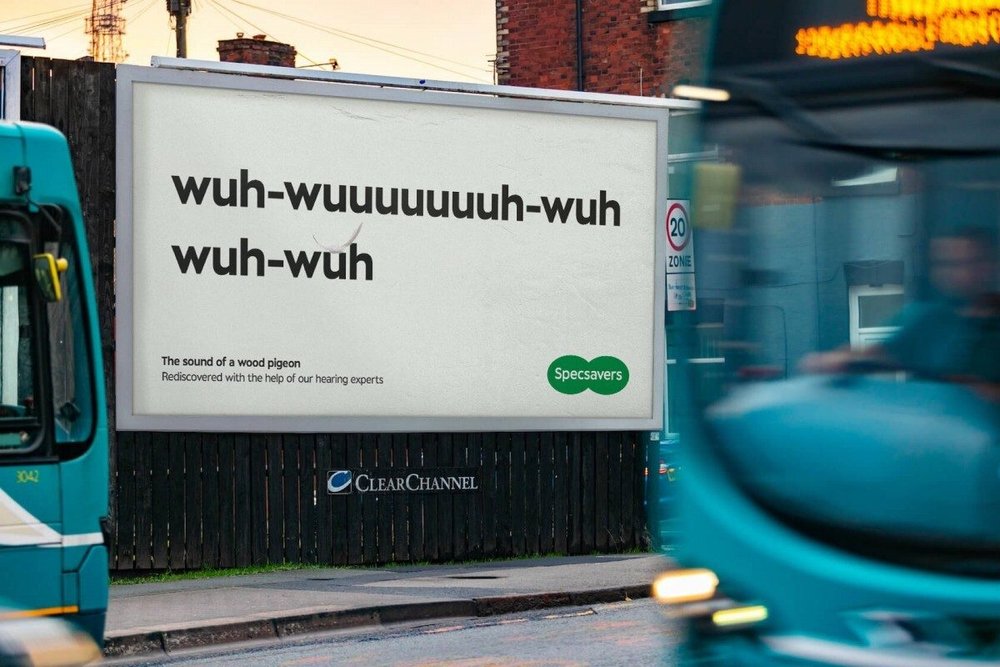
In November of the same year, The Misheard Version, sought to bring a nationwide hearing test to the public. Specsavers partnered with 1980s popstar Rick Astley to re-record his hit ‘Never Gonna Give You Up’. The song was rewritten to include some of the public’s most puzzlingly misheard lines, such as replacing ‘A full commitment’s what I’m thinking of’, with ‘A broken mitten’s what I’m thinking of’.
Astley teased the campaign by sharing the song on X. Later, Specsavers released a 2min30 spot across Facebook, Instagram, X, TikTok and YouTube explaining the adaptation of the song, with production footage from behind the scenes.
The teaser tweet on Astley’s social channels became his most-viewed post of all time. Having set a target of a 5% increase in hearing test bookings during launch week, Specsavers drastically exceeded this, reporting a 66% year-on-year increase. The campaign garnered 400 pieces of coverage, with a reach of more than 100 million. Earned coverage also directly drove business impact: TV coverage on Lorraine resulted in +19% on forecast (call centre volume), and This Morning coverage drove +15%.
Specsavers had taken a familiar experience and used it to open conversations about healthcare that most people may not think or want to think are relevant to them. As Alex Wood, chief creative officer at Golin, says, ‘The conversation around hearing loss is focused on ageing and serious decline. It’s really heavy and negative. Unsurprisingly, no one wants to hear about it. But mishearing is considered everyday and universal. It connects you to others through that shared experience.’
In the public eye
The Misheard Version demonstrated the value of earned media in tackling Specsavers’ perception issue. ‘Of course, in a TV ad you’re going to be speaking highly of your own business that you’re paying millions to talk about,’ notes Hale. ‘Whereas when you earn the attention, and you have [TV presenter and GP] Dr Hilary sat on Good Morning Britain talking about your audiology services. That’s about you. Trust is coming from a third party; an advocate was talking about your business.’
For Specsavers, earned-led campaigns address two challenges. Among its core over 45s demographic, they offer a layer of social proof and endorsement from authority to validate Specsavers’ expertise in sight and hearing. For younger audiences who aren’t as familiar with the Should’ve TV ads it’s reintroducing them to the brand. ‘It’s re-educating on who we are, our tone of voice, that we offer a really good range, because we’re a 40-year-old high street brand,’ says Hale. ‘An older audience knows this already.’
Specsavers has grown its relevance with younger audiences by adopting a publisher approach to social media. One example is Specsavers’ YouTube mini-series Best Worst Team, now in its third series. The brand partnered with the worst performing amateur football team in the UK, Cwym Albion, to document the club’s progress as it hopes to build on a season that saw it lose all 21 games and ship over 200 goals. The series features former Premier League manager Harry Redknapp, who helps coach the team, and retired England international Jill Scott on voiceover.
Best Worst Team has achieved a combined 35 million impressions across all platforms, generated over 800,000 consumer interactions with Specsavers and got record-breaking views. It has gained 360+ pieces of blanket national and local press coverage. Overall, brand perception points have grown by 10% on average. Likability has grown among all age groups, peaking at 81%. Consideration improved between 61% and 68% across all age groups. For just 1.5% of the total marketing budget the series has secured 15% incremental brand recognition beyond broader Specsavers ATL activity.
The campaign taps into the brand’s long-term goal of building brand affinity over time. ‘We saw a 10% increase in recognition among younger audiences at Specsavers who hadn’t seen any of our other advertising that was running at the same time’, says Hale.
Katherine Arnull, Golin
Seeing the bigger picture
One factor that has helped Specsavers take a more long-term approach to its advertising is the stability of its leadership; Doug and Mary Perkins have owned the brand since 1984. Having the same people at the helm of the company, and the input of the brand’s long-running in-house agency Specsavers Creative, has kept the brand’s communications and tone of voice consistent. James notes, ‘If you’re going to an agency, getting people to re-pitch every few years, it wouldn't have that same continuity. There's a lot of complexity in the business because it's got a retail and a medical side to it. To understand the relationship between the two, and understand the legislation that's around, that's quite an ask.’
Based on the small island of Guernsey, the in-house agency team has also helped Specsavers operate outside the London bubble, argues James, helping the brand retain its broad appeal with the public across the UK. ‘We've got quite a few stores in London, but the majority are not in London,’ adds James. ‘We're not a niche advertiser, we're there for everyone.’
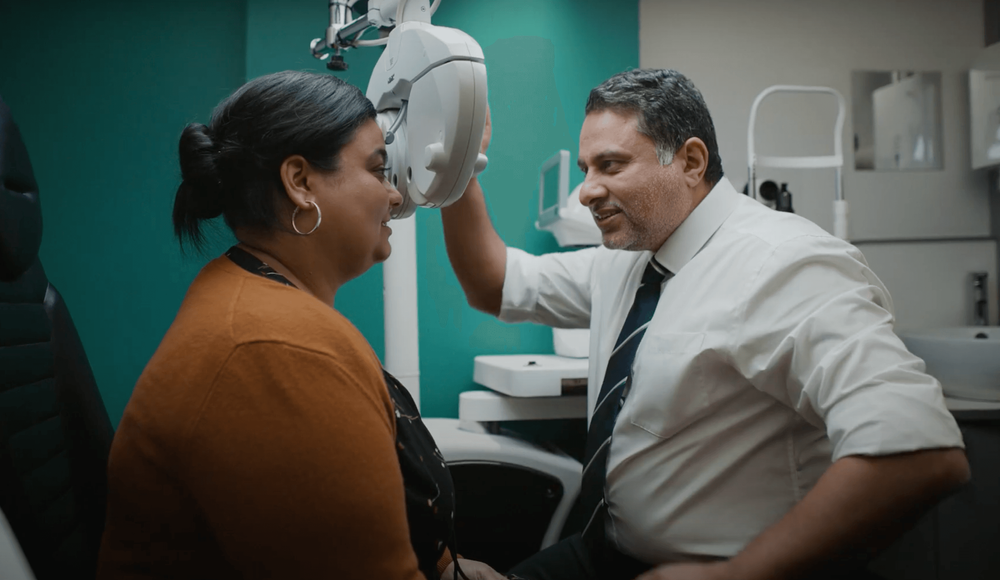
A lens on the future
As of Q1 2024, Specsavers ranked eighth in a YouGov survey of the UK’s most popular retail brands. It also ranked second for fame with a recognisability score of 99%, only behind Barbie. It's a remarkable feat for a brand that sits in a low interest category, which, beyond eye tests, can only regularly serve the 59% of people in the UK who wear glasses.
Specsavers has accrued this popularity by creating a presence that transcends optometry and audiology. As Katherine Arnull, UK group chief strategy officer at Golin, says, ‘They’re one of those fabric of the nation brands, something that people just associate with British culture.’ While much of this brand equity has been built through humour and the popularity of the Should’ve brand platform, looking forward Specsavers will continue to marry it with stories that showcase its healthcare credentials. The sight gags will always be part of the marketing mix, but it’s the next evolution of the platform that opens the door for more purpose-focused conversations.
Crucially though, the brand will never again abandon its distinctive tone of voice; Specsavers knows what it is good at and why it is loved. The next step is making sure that, however the jokes are framed, people see Specsavers for the expert in sight and hearing care that it is. As James says, ‘It’s a serious business, humour.’
